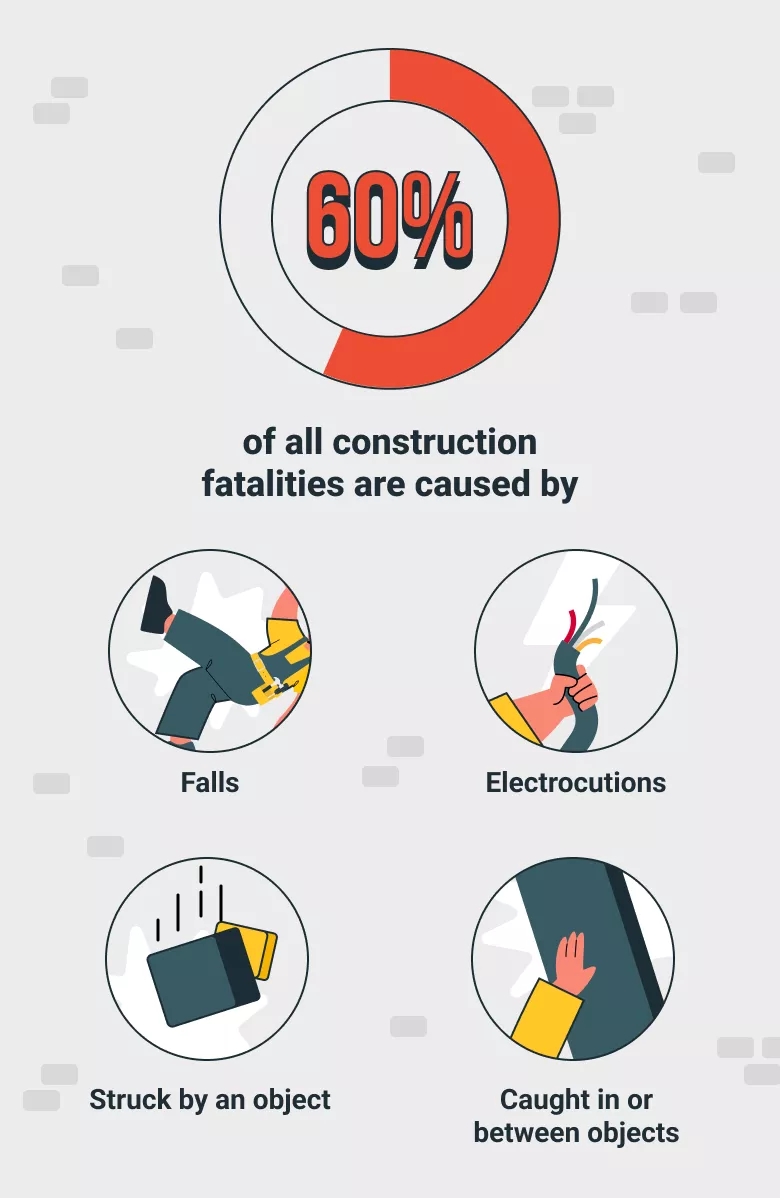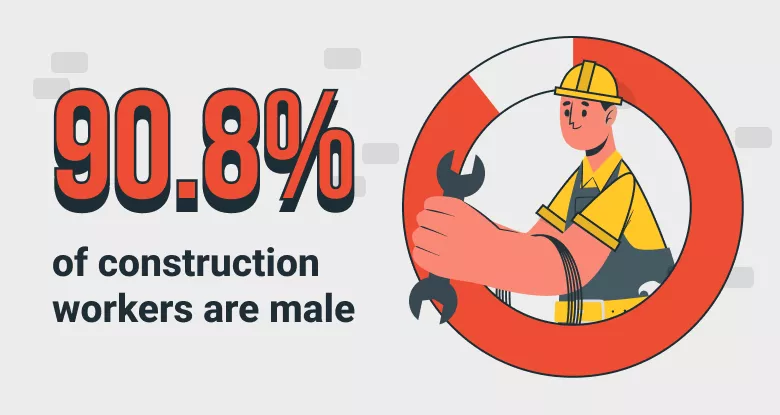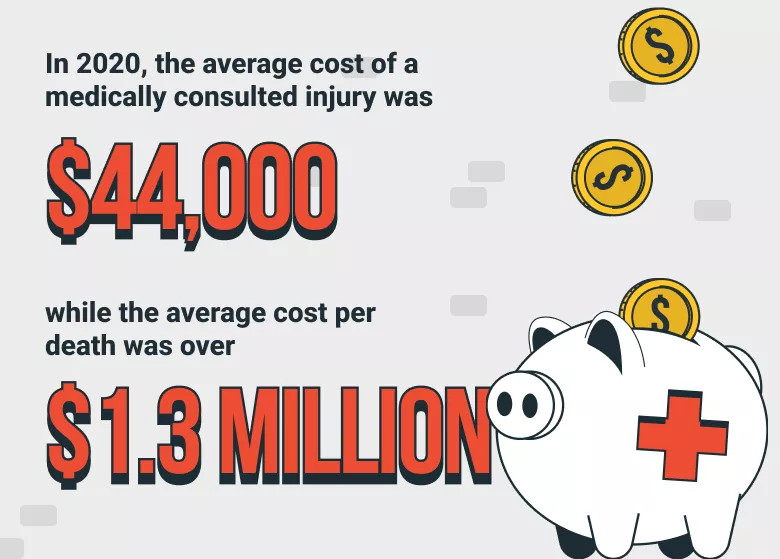35 Construction Safety Statistics
According to the CDC, between 2011 and 2019, the number of people employed in construction work increased by 25%, to 11.4 million. The industry remains one of the most dangerous in the US, with construction workers making up a fifth of all workplace deaths, despite accounting for just 6% of the national workforce.
As well as workplace fatalities, construction workers also have to contend with poor site safety, high accident rates and low levels of health insurance cover. To help get a clearer picture of what’s happening on the country’s construction sites, we’re taking an in depth look at some key construction safety statistics.
Safety and Health Risks in Construction
Due to the nature of their jobs, construction workers have to deal with a wide range of health and safety issues.
- 1. 60% of all construction fatalities are caused by falls, electrocutions, being struck by falling objects and being caught in or between objects. These are known as the ‘fatal four’ by the Occupational Safety and Health Administration (OSHA).

- 2. Falls are also a leading cause of non-fatal construction injuries. In 2019, they accounted for 32% of nonfatal injuries on construction sites. [BLS]
- 3. Non-fatal injuries in the construction industry resulted in an average of 28 lost days of work.
- 4. The most dangerous jobs on construction sites are those that involve working at height. This includes roofers and scaffolders.
- 5. Construction workers aged 25 – 34 years old are those most likely to suffer an accident on the job and experience work-related injuries [NSC].
Fatal Injuries in the Construction Industry
The construction industry suffers from an extremely high rate of fatal occupational injuries. The majority are caused by falls, but electrocutions, falling objects and collisions also account for a significant number of fatalities on U.S worksites every year.
- 6. The fatality rate for the construction and extraction industry in 2021 was 12.3 per 100,000 full time workers. That was down from 13.5 deaths per 100,000 full-time workers in 2020, but still considerably above the national average of 3.6. [BLS]
- 7. According to the Bureau of Labor Statistics (BLS), there were a total of 1,034 construction-related deaths in 2020. [BLS]
- 8. Of these 1,034 fatalities, over a third (371) were caused by trips, slips and falls – 353 people suffered fatal injuries from falling to a lower level and there were 9 fatal falls on the same level.
- 9. Forty-two people died in crane-related accidents. Around 60% of these deaths involved falling objects.
- 10. A fifth of all worker deaths in the US in 2020 were in the construction industry. That’s despite construction workers making up just 6% of the country’s workforce. [OSHA]
Non-Fatal Injuries in Construction
Non-fatal injuries result in days off work, lost productivity, high insurance premiums and poor employee morale.
- 11. 6% of all injuries that result in days away from work occur in the construction industry. [BLS]
- 12. The workplace injuries most likely to result in days off work are musculoskeletal disorders. [BLS]
- 13. Injury and illness rates in construction were almost a quarter higher than they were across all industries on average in 2020. [BLS]
- 14. One in four construction workers admits that they’ve failed to report a work-related injury. [CPWR]
- 15. A total of 174,100 construction injuries occurred in 2020.
Impact of Demographics of Construction Workers and Safety
The demographics of the construction industry could help to explain its unusually high accident rate.
- 16. The vast majority, 90.8%, of construction workers are male. Research has shown men are significantly more likely to experience an injury in the workplace. In 2012, 92% of all worker fatalities occurred amongst male employees. [NCBI]

- 17. Construction companies employ a lot of young men. Studies have shown that young people have lower risk perception than more experienced construction laborers. [NCBI]
- 18. Although they are more likely to suffer workplace accidents, 24% of construction workers were uninsured in 2018. More than twice the uninsured rate among all U.S. workers (11%). [PNHP]
- 19. Nearly 48% of Hispanic construction workers are uninsured.
- 20. The number of fatal injuries among Hispanic workers increased 90% from 2011 to 2019. [CDC]
Education and Training vs. Accident Rates in Construction
Proper health and safety training on job sites can help to significantly reduce the number of employees who suffer fatal and non-fatal accidents every year.
- 21. Over half (55%) of construction workers believe they need more safety training. [360training]
- 22. OSHA estimates that construction companies could save $4 to $6 for every $1 they invest in safety training.
- 23. On average, construction companies spend 3.6% of their budgets on injuries and workers’ compensation claims, but only 2.6% on construction safety training. [LHSFNA]
- 24. Over 60% of construction accidents occur within an employee’s first year of work, often before they’ve had a chance to undertake proper safety training. [BLS]
- 25. More than two-thirds (67%) of construction workers feel safety standards are lower than those for productivity. [EHSTODAY]
Cost of Injuries and Fatalities in the Construction Industry
Injuries and fatalities cost construction businesses in a number of different ways. From lost productivity to workers’ compensation claims, accidents in the workplace can have a significant impact on a company’s bottom line, as well as on the wellbeing of its staff.
Did you know? Having a surety bond can provide significant benefits to contractors, particularly in terms of reducing financial risk. By securing a surety bond, contractors can reassure clients that they will complete projects in any case.
- 26. In 2020, the average cost of a medically consulted injury was $44,000, while the average cost per death was over $1.3 million. [NSC]

- 27. The total cost of fatal and non-fatal construction accidents in 2020 was $163.9 billion.
- 28. According to the BLS, more than 130,000 construction workers missed days of work in 2020 due to illness or injury.
- 29. Every year, fatal construction injuries are estimated to cost the United States $5 billion in healthcare costs, lost income, reduced quality of life for family members and lost productivity. [MIDWESTEPI]
- 30. In 2020, accidents on construction sites resulted in almost $45 billion being lost in wages and productivity alone. [NSC]
Regulations and Guidelines Effectiveness in Reducing Incidents
Regulations and guidelines are already in place to ensure construction workers are as protected as possible. Following these to the letter can help to dramatically improve site safety.
- 31. According to the National Safety Council (NSC), fall protection has been the most cited OSHA violation for the past decade.
- 32. The chances of a fall being fatal were more than three-quarters (76%) lower for workers who had self-rescue training.
- 33. The likelihood of a worker using fall protection was 71% lower for individuals whose employer or competent person did not do any planning.
- 34. In over a quarter (27%) of cases, insufficient or ineffective planning was the most selected primary cause for falls.
- 35. Employees who believe fall protection is required by their employer are eight times more likely to use it.
- Fast and Secure Application
- Nationwide Coverage
- Approval in Minutes
- Money Back Guarantee
Recommended Articles
- Fast and Secure Application
- Nationwide Coverage
- Approval in Minutes
- Money Back Guarantee
- Image

- Image

- Image

Lance Surety Bond Associates, Inc. is a surety bond agency based out of southeastern Pennsylvania that is able to write all surety bond types in all 50 states. We are dedicated to servicing all of our customers' surety bonding needs throughout the country and guarantee competitive rates, timely responses, and unparalleled customer service.






